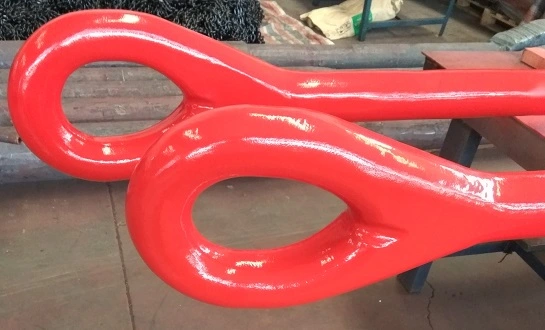How to Conduct a Safety Check on Your Elevator Link?
If you care about the longevity and dependability of your lifting machinery, you must regularly inspect the Elevator Link for damage. An essential part of the hoisting system, a Elevator Link connects the lift to the drilling line. In order to stay safe, keep operations running smoothly, and meet all industry regulations, regular inspections are a must. With the aid of this detailed guide, you can inspect your product for any possible safety flaws and fix them before they become major problems. A safer working environment in the oilfield business may be yours when you follow these procedures to maintain the functioning and safety of your lift system.

Essential Components to Inspect in Elevator Links
When conducting a safety check on your elevator link, it's important to focus on key components that are critical to its performance and safety. Here are the essential elements you should examine:
Body and Arms
The body and arms of the elevator links are the primary load-bearing components. Inspect these areas for any signs of wear, deformation, or damage. Look for:
- Cracks or fractures
- Bent or twisted sections
- Corrosion or rust
- Excessive wear on contact surfaces
Pivot Points and Joints
The pivot points and joints allow for the proper movement and articulation of the elevator link. Check these areas for:
- Loose or missing bolts
- Worn bushings or bearings
- Proper lubrication
- Alignment issues
Locking Mechanisms
The locking mechanisms ensure that the elevator link remains securely attached to the drill pipe or casing. Examine these components for:
- Proper engagement and disengagement
- Wear on locking surfaces
- Damaged or missing springs
- Smooth operation of latches or pins
Surface Coatings and Markings
The surface coatings protect the elevator link from corrosion and provide important information. Inspect these areas for:
- Peeling or chipping of protective coatings
- Legibility of capacity markings and serial numbers
- Presence of required safety labels
Step-by-Step Guide: Performing a Thorough Link Examination
To ensure a comprehensive safety check of your elevator link, follow these detailed steps:
1. Visual Inspection
Begin with a thorough visual examination of the entire elevator link. Look for any obvious signs of damage, wear, or deformation. Pay close attention to:
- Welds and connection points
- Surface conditions
- Symmetry of components
- Presence of all required parts
2. Dimensional Checks
Use precision measuring tools to verify that the elevator link's dimensions are within the manufacturer's specifications. Measure:
- Overall length and width
- Thickness of load-bearing sections
- Diameter of pivot points
- Clearances between moving parts
3. Functional Testing
Perform operational tests to ensure that all moving parts function as intended. This includes:
- Opening and closing the elevator link
- Engaging and disengaging locking mechanisms
- Checking for smooth rotation at pivot points
- Verifying proper alignment when closed
4. Non-Destructive Testing (NDT)
For a more in-depth examination, consider employing non-destructive testing methods such as:
- Magnetic particle inspection to detect surface and near-surface flaws
- Ultrasonic testing to identify internal defects
- Dye penetrant testing for surface crack detection
5. Load Testing
Periodically conduct load tests to verify the elevator link's capacity and performance under stress. This should be done according to industry standards and manufacturer recommendations.
6. Documentation Review
Examine all relevant documentation, including:
- Maintenance records
- Previous inspection reports
- Manufacturer's guidelines and specifications
- Certification documents
Common Elevator Link Issues and Their Warning Signs
Being aware of potential problems and their indicators can help you identify issues early and prevent equipment failure. Here are some common elevator link issues and their warning signs, and consulting a Elevator Link manufacturer can provide valuable guidance on how to address them effectively.
Wear and Tear
Normal use can lead to gradual deterioration of the elevator link. Watch for:
- Excessive play in joints or pivot points
- Visible reduction in component thickness
- Smooth or polished areas on load-bearing surfaces
Stress Cracks
Repeated loading and unloading can cause stress cracks to develop. Look for:
- Fine lines or cracks near welds or high-stress areas
- Discoloration around potential crack sites
- Unusual sounds during operation
Corrosion Damage
Exposure to harsh environments can lead to corrosion. Be alert for:
- Pitting or scaling on metal surfaces
- Flaking or bubbling of protective coatings
- Red or white powdery deposits
Misalignment
Improper use or damage can cause misalignment issues. Check for:
- Difficulty in opening or closing the elevator link
- Uneven wear patterns on contact surfaces
- Visible gaps or inconsistencies when the link is closed
Locking Mechanism Failures
Problems with locking mechanisms can lead to dangerous situations. Watch for:
- Sluggish or inconsistent latch operation
- Visible damage to locking components
- Incomplete engagement of locking devices
Conclusion
To keep your oilfield operation safe and running smoothly, you must inspect your Elevator Link often and thoroughly. Equipment failure and accidents in the workplace may be greatly reduced by thoroughly evaluating all critical components, following an organised inspection method, and being alert for typical problems and their symptoms. Always make sure that trained individuals are conducting safety inspections in compliance with all applicable regulations and the guidelines provided by the manufacturer. Maintaining compliance and keeping track of equipment history requires thorough documentation of all inspections and maintenance actions. In the dangerous and unpredictable oil and gas industry, you can help create a safer workplace and ensure more dependable operations by paying close attention to the condition of your lift connections.
Ensure Safety and Reliability with Welong's Premium Elevator Links
When it comes to ensuring the safety and reliability of your oilfield operations, choosing the right elevator link manufacturer is crucial. When it comes to Elevator Links, Welong is head and shoulders above the competition. Their goods are second to none. The enhanced strength, durability, and performance of our Elevator Links are the consequence of their construction from premium alloy steel employing modern production procedures. You can trust that your equipment will be able to endure the harsh circumstances of oilfield operations when you use Welong's Elevator Link. For all of your Elevator Link requirements, go with Welong. Safety is our first priority. Contact us today at oiltools15@welongpost.com to learn more about our products and how we can support your operations.
References
1. American Petroleum Institute. (2024). API Specification 8C: Drilling and Production Hoisting Equipment (PSL 1 and PSL 2). Washington, D.C.: API Publishing Services.
2. International Association of Drilling Contractors. (2025). IADC Drilling Manual, 12th Edition. Houston, TX: IADC.
3. Occupational Safety and Health Administration. (2023). Oil and Gas Well Drilling and Servicing eTool: Drilling - Elevators. Washington, D.C.: U.S. Department of Labor.
4. Society of Petroleum Engineers. (2024). SPE Technical Report: Best Practices for Oilfield Lifting Equipment Inspection and Maintenance. Richardson, TX: SPE.
5. National Oilwell Varco. (2025). Elevator Links: Inspection and Maintenance Guide. Houston, TX: NOV Technical Publications.
6. Bureau of Safety and Environmental Enforcement. (2023). Safety Alert: Elevator Link Failures in Offshore Operations. Washington, D.C.: U.S. Department of the Interior.

Share your inquiry, get the quotation accordingly!

CHINA WELONG - 20+ years manufactuer in oilfield tools


